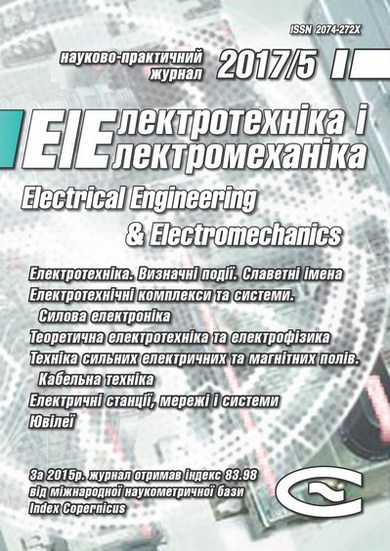THE EVALUATION OF POSSIBILITY OF NORMAL OPERATION OF CABLES BASED ON TWISTED PAIRS WITH PVC JACKET UNDER THE CONDITIONS OF HIGH HUMIDITY AND TEMPERATURE
DOI:
https://doi.org/10.20998/2074-272X.2017.5.08Keywords:
cables based on twisted pairs for shipbuilding, accelerated aging, hygroscopic moistening, thermal aging, partial capacitance, tangent of the dielectric loss angle, service lifeAbstract
Introduction. Development of cables for structured cabling systems based on twisted pairs for shipbuilding is carried out in two main directions: increasing the fire safety of cables and increasing the long-term permissible operating temperature by using new, more heat-resistant, electrical insulating materials. Purpose. Substantiation of the possibility of unshielded cables on the basis of unshielded twisted pairs with thermoplastic polyethylene insulation in PVC protective jacket in conditions of high humidity and high operating temperatures on the basis of the results of accelerated aging. Methodology. The cycle of aging under conditions of increased humidity is performed for 336 hours. Then the sample was under natural drying conditions for 1440 hours. Thermal aging in a thermostat at 90 °C was carried out in two stages: first – for 206 hours, the second – for 260 hours. In the initial state and after accelerated aging, measurements of the capacitance and tangent of the dielectric loss angle of all the insulating gaps at frequencies of 100 Hz, 1 and 10 kHz were performed. Results. According to the results of accelerated aging under conditions of high humidity and temperature, it is established that the design of an unshielded cable based on unshielded twisted pairs with thermoplastic polyethylene insulation in a protective coating based on PVC-plastic is resistant to external influencing factors. Practical value. The prolonged holding at temperature of 90 °C is equivalent to operation at temperature of 40 °C for 6.8 years. At higher operating temperatures, the lifetime of the cable is significantly reduced.References
1. IEC 60092-359:2014, Electrical Installations In Ships – Part 359: Sheathing Materials For Shipboard Power And Telecommunication Cables By IEC TC/SC 18A. 50 p.
2. IEC 60332-1-2:2004, Tests on electric cables under fire conditions – Part 1: Test on a single vertical insulated wire or cable.
3. Bezprozvannych G.V., Nabokа B.G., Morozova E.V. Radiating resistance of common commercial cables of internal laying. Electrical engineering & electromechanics, 2006, no.3, pp. 82-86. doi: 10.20998/2074-272X.2006.3.16. (Rus).
4. Bezprozvannych A.V., Naboka B.G., Moskvitin E.S. Examination of the three-phase insulation of cables in a metal shell. Electricity, 2010, no.1, pp. 48-54. (Rus).
5. Bezprozvannych A.V. The electrical scanning of the transverse structure by multicore cables by the method of cumulative measurements. Tekhnichna elektrodynamika, 2008, no.3, pp. 30-36. (Rus).
Downloads
Published
How to Cite
Issue
Section
License
Copyright (c) 2017 G. V. Bezprozvannych, I. A. Mirchuk

This work is licensed under a Creative Commons Attribution-NonCommercial 4.0 International License.
Authors who publish with this journal agree to the following terms:
1. Authors retain copyright and grant the journal right of first publication with the work simultaneously licensed under a Creative Commons Attribution License that allows others to share the work with an acknowledgement of the work's authorship and initial publication in this journal.
2. Authors are able to enter into separate, additional contractual arrangements for the non-exclusive distribution of the journal's published version of the work (e.g., post it to an institutional repository or publish it in a book), with an acknowledgement of its initial publication in this journal.
3. Authors are permitted and encouraged to post their work online (e.g., in institutional repositories or on their website) prior to and during the submission process, as it can lead to productive exchanges, as well as earlier and greater citation of published work.





